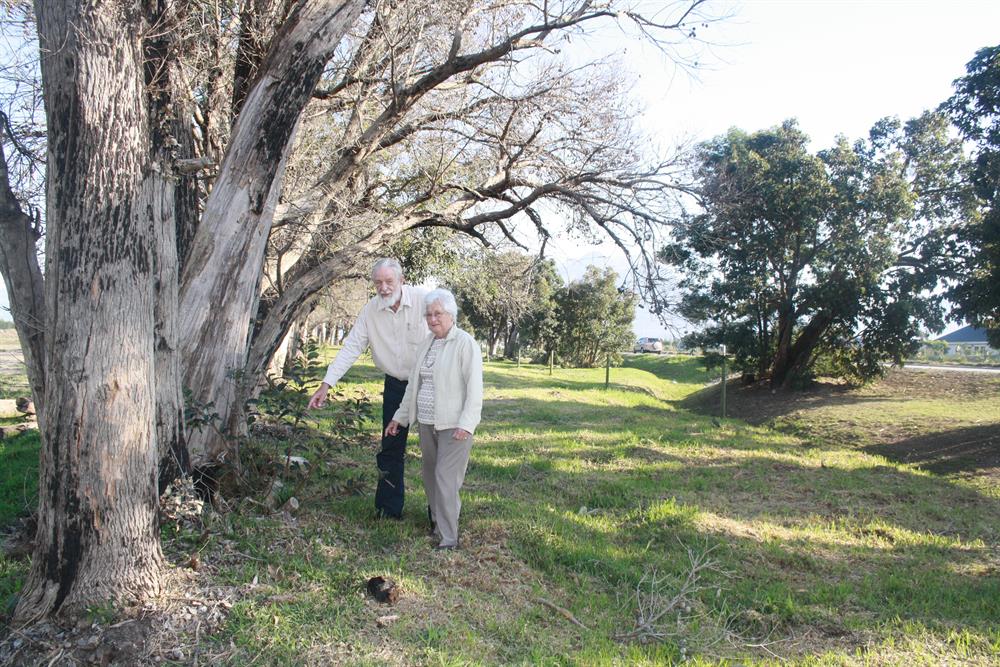The trees - red flowering gums from Australia (eucalyptus ficifolia) - are found on the eastern side of George, next to CTM on Knysna Road, in the direction of Wilderness. It is a decorative tree, but it is not listed as an invasive alien.
Two rows of trees are visible. According to Lynne Thompson, a member of the George Heritage Trust, the trees are the remnants of the avenue that graced the old road from George to Victoria Bay for many years before the road went to Wilderness.
The row nearest to the road on municipal ground is lush green and is in sharp contrast to the second row of dying trees, situated on private ground.
This portion of land behind the trees was purchased three years ago, in October 2011, by the developer Fynbos Road Hole Investments. A Garden Route Auto City is destined for this location.
Hiding the business behind trees
One of the conditions of approval laid down by Heritage Western Cape for the proposed development by Fynbos Road Hole Investments was "the retention of the existing eucalyptus trees along Knysna Road".
The developer stated in a letter to the municipality that the retention of these trees does pose a problem to them. "However, by hiding the business behind trees will effectively render the Knysna Road street front valueless - which will make no business sense and substantially reduce the attractiveness to invest in the region".
In their request, Fynbos Road Hole Investments asked the municipality to "reconsider their interpretation regarding the retention of the eucalyptus trees within the erf boundary".
They undertook that the row "between the street and erf boundary (the row of trees on municipal ground) will be retained unharmed".
In a statement George Municipality confirmed that the trees referred to are located on private land. "With the granting of the enviromental authority, the record of decision included the condition that the trees must be protected. It must be noted however that the enforcement of this record of decision falls under the Provincial Department of Environmental Affairs and Development Planning."
The developer acknowledged receipt of questions from the George Herald regarding their plans with the trees, but did not respond before going to press.
Poisoned trees
Information reveals that the line of visibly dying gum trees were poisoned at least twice since the purchase of the ground.
According to Thompson, several experts - including botanical scientists and a representative of the Western Cape Department of Environmental Affairs - confirmed that signs of poisoning are evident.
Sarel Theron, a retired lecturer in horticulture at the Nelson Mandela Metropolitan University, is very certain that the trees were indeed poisoned. Theron lectured for 30 years on plant illnesses and weed control among other things.
"They were definitely poisoned. Gum trees don't die all at once, in a row," said Theron.
"My guess is that it could have been a mixture between the poison Garlon and diesel. It would have taken four to five months for the trees to die."
According to Theron, the chances for these trees to survive their ordeal is very slim. "The poison targets the root system. In my opinion they are already dead," he said.
Thompson argued that the trees can be saved, because of their deep root systems. "The deep roots makes the tree hard to kill as evidenced by isolated signs of regrowth since mid 2013, and the need for successive applications of poison," said Thompson.
Blooming history
Research by Thompson indicates that the avenue was planted in about 1900. The George Herald and Knysna Herald of 1939 reported that the avenue along the Victoria Bay road was an impressive sight with their striking red blooms and that the trees should be planted all over George to beautify the town.
The trees start flowering after six years and may grow to hundreds of years old, bearing bunches of attractive red flowers every summer. Red flowering gum trees were planted in the grounds soon after the forestry college at Saasveld was started in 1934.
• The George Heritage Trust has been asked to provide a set of its distinctive commemorative plaques at the CTM corner on Knysna Road, which marks the start of this fine reminder of the town’s heritage.

Joh Groenewald and Lynne Thompson investigating the line of dying trees. Photo: Michelle Pienaar
ARTICLE: MICHELLE PIENAAR, GEORGE HERALD JOURNALIST
'We bring you the latest George, Garden Route news'
















